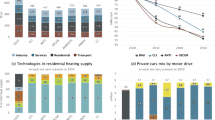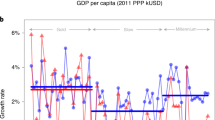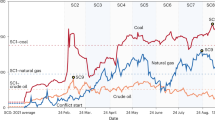Abstract
Energy systems are subject to strong and long-lived path dependence, owing to technological, infrastructural, institutional and behavioural lock-ins. Yet, with the prospect of providing accessible cheap energy to stimulate economic development and reduce poverty, governments often invest in large engineering projects and subsidy policies. Here, I argue that while these may achieve their objectives, they risk locking their economies onto energy-intensive pathways. Thus, particularly when economies are industrializing, and their energy systems are being transformed and are not yet fully locked-in, policymakers should take care before directing their economies onto energy-intensive pathways that are likely to be detrimental to their long-run prosperity.
This is a preview of subscription content, access via your institution
Access options
Subscribe to this journal
Receive 12 digital issues and online access to articles
$119.00 per year
only $9.92 per issue
Buy this article
- Purchase on Springer Link
- Instant access to full article PDF
Prices may be subject to local taxes which are calculated during checkout

Similar content being viewed by others
References
Arthur, W. B. Competing technologies, increasing returns, and lock-in by historical events. Econ. J. 99, 116–131 (1989).
David, P. A. Clio and the economics of QWERTY. Am. Econ. Rev. 75, 332–337 (1985).
Cowan, R. Nuclear power reactors: a study in technological lock-in. J. Econ. Hist. 50, 541–567 (1990).
Cowan, R. & Hultén, S. Escaping lock-in: the case of the electric vehicle. Technol. Forecast. Social Change 53, 61–80 (1996).
Unruh, G. C. Understanding carbon lock-in. Energy Policy 28, 817–830 (2000).
Unruh, G. C. Escaping carbon lock-in. Energy Policy 30, 317–325 (2002).
Foxon, T. J., Pearson, P. J. G., Arapostathis, S., Carlsson-Hyslop, A. & Thornton, J. Branching points for transition pathways: assessing responses of actors to challenges on pathways to a low carbon future. Energy Policy 52, 146–158 (2013).
Acemoglu, D., Aghion, P., Bursztyn, L. & Hemous, D. The environment and directed technical change. Am. Econ. Rev. 102, 131–166 (2012).
Acemoglu, D., Akcigit, U., Hanley, D. & Kerr, W. Transition to clean technology. J. Polit. Econ. 124, 52–104 (2016).
Wolfram, C., Shelef, O. & Gertler, P. How will energy demand develop in the developing world? J. Econ. Persp. 26, 119–138 (2012).
IIASA Global Energy Assessment: Toward a Sustainable Future (eds Johansson, T. B. et al.) (Cambridge Univ. Press, 2012).
Donaldson, D. & Hornbeck, R. Railroads and American economic growth: a ‘market access’ approach. Q. J. Econ. 131, 799–858 (2016).
Hughes, T. P. Networks of Power: Electrification in Western Society, 1880–1930 (Johns Hopkins Univ. Press, 1983).
Wright, G. The origins of American industrial success, 1879–1940. Am. Econ. Rev. 80, 651–668 (1990).
Fernihough, A. & O'Rourke, K. H. Coal and the European Industrial Revolution NBER Working Paper 19802 (National Bureau of Economic Research, 2014).
Grubler, A. The Rise and Fall of Infrastructures: Dynamics of Evolution and Technological Change in Transport (Physica, 1990).
Goodwin, P. B. Empirical evidence on induced traffic, a review and synthesis. Transportation 23, 35–54 (1996).
Hymel, K., Small, K. & van Dender, K. Induced demand and rebound effects in road transport. Transport. Res. B 44, 1220–1241 (2010).
Duranton, G. & Turner, M. A. The fundamental law of road congestion: evidence from US cities. Am. Econ. Rev. 101, 2616–2652 (2011).
Nye, D. E. Consuming Power: A Social History of American Energies (MIT Press, 1998).
Hirschman, A. O. Development Projects Observed (Brookings Inst., 1967).
Flyvbjerg, B. What you should know about megaprojects and why: an overview. Project Managem. J. 45, 6–19 (2014).
Ansar, A. Flyvbjerg, B., Budzier, A. & Lunn, D. Should we build more large dams? The actual costs of hydropower mega project development. Energy Policy 69, 43–56 (2014).
Grubler, A. The costs of the French nuclear scale-up: a case of negative learning by doing. Energy Policy 38, 5174–5188 (2010).
Sovacool, B. K. & Cooper, C. J. The Governance of Energy Megaprojects: Politics, Hubris, and Energy Security (Edward Elgar, 2013).
Thomas, J. J. Kerala's industrial backwardness: a case of path dependence in industrialization? World Dev. 33, 763–783 (2005).
Kitchens, C. The role of publicly provided electricity in economic development: the experience of the Tennessee Valley Authority, 1929–1955. J. Econ. Hist. 74, 389–419 (2014).
Toman, M. T. & Jemelkova, B. Energy and economic development: an assessment of the state of knowledge. Energy J. 24, 93–112 (2003).
Fouquet, R. The role of energy technologies in long run economic growth. IAEE Energy Forum 8, 11–13 (2014).
Stern, D. I. & Kander, A. The role of energy in the Industrial Revolution and modern economic growth. Energy J. 33, 127–54 (2012).
Pearson, P. J. G. Energy transitions. New Palgrave Dictionary of Economics online edition (eds Durlauf, S. & Blume, L. ) (Palgrave Macmillan, 2016).
Fouquet, R. Divergences in long run trends in the prices of energy and energy services. Rev. Environ. Econ. Policy 5, 196–218 (2011).
Sue Wing, I. Explaining the declining energy intensity of the U.S. economy. Resour. Energy Econ. 30, 21–49 (2008).
Csereklyei, Z., Rubio Varas, M. d. M. & Stern, D. I. Energy and economic growth: the stylized facts. Energy J. 37, 223–255 (2016).
van Benthem, A. Energy leapfrogging. J. Assoc. Environ. Resour. Econ. 2, 93–132 (2015).
Stern, D. I. Modeling international trends in energy efficiency. Energy Econ. 34, 2200–2208 (2012).
Bleakley, H. & Lin, J. Portage and path dependence. Q. J. Econ. 127, 587–644 (2012).
Michaels, G. & Rauch, F. Resetting the Urban Network: 117–2012 Economics Series Working Papers 684 (Univ. Oxford Department of Economics, 2013).
Meng, K. C. Path dependence in U.S. coal-fired electricity. Am. Econ. Assoc. Annu. Meeting (4 January 2016).
Glaeser, E. L., Kerr, S. P. & Kerr, W. R. Entrepreneurship and urban growth: empirical assessment with historical mines. Rev. Econ. Stat. 97, 498–520 (2015).
Stuetzer, M. et al. Industry structure, entrepreneurship, and culture: an empirical analysis using historical coalfields. Eur. Econ. Rev. 86, 52–72 (2016).
Gerard, F. What Changes Energy Consumption, and for How Long? New Evidence from the 2001 Brazilian Electricity Crisis RFF Discussion Paper 13–06 (Resources for the Future, 2013).
Pezzey, J. C. V. The influence of lobbying on climate policies; or, why the world might fail. Environ. Dev. Econ. 19, 329–332 (2014).
Laffont, J. J. & Tirole, J. A Theory of Incentives in Procurement and Regulation (MIT Press, 1993).
Glachant, J. M. & Finon, D. A competitive fringe in the shadow of a state owned incumbent: the case of France. Energy J. 26, (European Electricity Liberalisation special issue) 181–204 (2005).
Meng, K. C. Using a Free Permit Rule to Forecast the Marginal Abatement Cost of Proposed Climate Policy NBER Working Paper 22255 (National Bureau of Economic Research, 2016).
The World's Biggest Public Companies (Forbes, accessed 29 November 2015); http://www.forbes.com/global2000/
Barbier, E. in Handbook on Energy and Climate Change (ed. Fouquet, R. ) 598–616 (Edward Elgar, 2013).
Coady, D, Parry, I., Sears, L. & Shang, B. How Large Are Global Energy Subsidies? IMF Working Paper WP/15/105 (IMF, 2015).
Pfund, N. & Healey, B. What Would Jefferson Do? The Historical Role of Federal Subsidies in Shaping America's Energy Future (DBL Investors, 2011).
Lipsey, R. G., Carlaw, K. I. & Bekar, C. T. Economic Transformations: General Purpose Technologies and Long Term Economic Growth 79 (Oxford Univ. Press, 2005).
Acurio-Vásconez, V., Giraud, G., McIsaac, F. & Pham, N. S. The effects of oil price shocks in a new-Keynesian framework with capital accumulation. Energy Policy 86, 844–854 (2015).
Popp, D. Innovation and energy prices. Am. Econ. Rev. 92, 160–180 (2002).
Newell, R. G., Jaffe, A. B. & Stavins, R. N. The induced innovation hypothesis and energy-saving technological change. Q. J. Econ. 114, 941–975 (1999).
Fowlie, M., Greenstone, M. & Wolfram, C. Are the non-monetary costs of energy efficiency investments large? Understanding low take-up of a free energy efficiency program. Am. Econ. Rev. 105, 201–204 (2015).
Gillingham, K. & Palmer, K. Bridging the energy efficiency gap: policy insights from economic theory and empirical analysis. Rev. Environ. Econ. Policy 8, 18–38 (2014).
Leiby, P. N. Estimating the Energy Security Benefits of Reduced U.S. Oil Imports ORNL/TM-2007/028 (Oak Ridge National Laboratory, 2007).
Goldthau, A. & Sovacool, B. K. The uniqueness of the energy security, justice, and governance problem. Energy Policy 41, 232–240 (2012).
Gillingham, K., Newell, R. & Palmer, K. Energy efficiency policies: a retrospective examination. Annu. Rev. Environ. Resour. 31, 193–237 (2006).
Demand-Side Management Program Direct and Indirect Costs (US Energy Information Administration, accessed 13 January 2016); http://go.nature.com/29kWJqJ
Auffhammer, M., Blumstein, C. & Fowlie, M. Demand side management and energy efficiency revisited. Energy J. 29, 91–104 (2008).
Fowlie, M., Greenstone, M. & Wolfram, C. Are the non-monetary costs of energy efficiency investments large? Understanding low take-up of a free energy efficiency program. Am. Econ. Rev. 105, 201–204 (2015).
Barbier, E. B. Scarcity and Frontiers: How Economies Have Developed Through Natural Resource Exploitation (Cambridge Univ. Press, 2011).
Delucchi, M. A. & Murphy, J. US military expenditures to protect the use of Persian-Gulf oil for motor vehicles. Energy Policy 36, 2253–2264 (2008).
Stiglitz, J. E. & Bilmes, L. J. The Three Trillion Dollar War: The True Cost of the Iraq Conflict (Norton, 2008).
Stiglitz, J. E. Rewriting the Rules of the American Economy Part 2 (2015); http://go.nature.com/28MnqWz
Caselli, F., Morelli, M. & Rohner, D. The geography of interstate resource wars. Q. J. Econ. 130, 267–315 (2015).
Statistical Review of World Energy 2015 (BP, 2015).
Duflo, E. & Pande, R. Dams. Q. J. Econ. 122, 601–646 (2007).
Aghion, P., Dechezlepretre, A., Hemous, D., Martin, R. & Van Reenen, J. Carbon taxes, path dependency and directed technical change: evidence from the auto industry. J. Polit. Econ. 124, 1–51 (2016).
Schmalensee, R. Lecture 5: Path Dependence in Energy Systems. MIT Open Courseware (Sloan School of Management, MIT, 2012); http://go.nature.com/28Kz5Au
Acemoglu, D. & Robinson, J. Why Nations Fail: The Origins of Power, Prosperity and Poverty (Crown Business, 2012).
Acknowledgements
I thank F. Green, A. Kopp and N. Stern for discussions. Financial support from the ESRC is gratefully acknowledged.
Author information
Authors and Affiliations
Corresponding author
Ethics declarations
Competing interests
The author declares no competing financial interests.
Rights and permissions
About this article
Cite this article
Fouquet, R. Path dependence in energy systems and economic development. Nat Energy 1, 16098 (2016). https://doi.org/10.1038/nenergy.2016.98
Received:
Accepted:
Published:
DOI: https://doi.org/10.1038/nenergy.2016.98
This article is cited by
-
Environmental regulation and energy efficiency: evidence from daily penalty policy in China
Journal of Regulatory Economics (2023)
-
The role of energy security and economic complexity in renewable energy development: evidence from G7 countries
Environmental Science and Pollution Research (2023)
-
Plausible energy demand patterns in a growing global economy with climate policy
Nature Climate Change (2021)
-
Increase in household energy consumption due to ambient air pollution
Nature Energy (2020)
-
Landscape sustainability and the landscape ecology of institutions
Landscape Ecology (2020)



